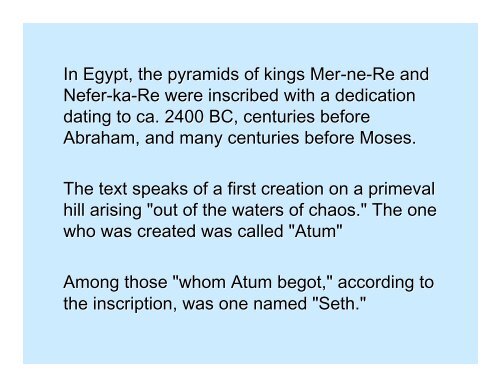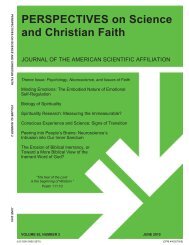In Egypt, the pyramids of kings Mer-ne-Re and Nefer-ka-Re were ...
In Egypt, the pyramids of kings Mer-ne-Re and Nefer-ka-Re were ...
In Egypt, the pyramids of kings Mer-ne-Re and Nefer-ka-Re were ...
You also want an ePaper? Increase the reach of your titles
YUMPU automatically turns print PDFs into web optimized ePapers that Google loves.
<strong>In</strong> <strong>Egypt</strong>, <strong>the</strong> <strong>pyramids</strong> <strong>of</strong> <strong>kings</strong> <strong>Mer</strong>-<strong>ne</strong> <strong>Mer</strong> <strong>ne</strong>-<strong>Re</strong> <strong>Re</strong> <strong>and</strong><br />
<strong>Nefer</strong>-<strong>ka</strong> <strong>Nefer</strong> <strong>ka</strong>-<strong>Re</strong> <strong>Re</strong> <strong>were</strong> inscribed with a dedication<br />
dating to ca. 2400 BC, centuries before<br />
Abraham, <strong>and</strong> many centuries before Moses.<br />
The text speaks <strong>of</strong> a first creation on a primeval<br />
hill arising "out <strong>of</strong> <strong>the</strong> waters <strong>of</strong> chaos." The o<strong>ne</strong><br />
who was created was called "Atum"<br />
Among those "whom Atum begot," according to<br />
<strong>the</strong> inscription, was o<strong>ne</strong> named "Seth."
Locating <strong>the</strong> Garden <strong>of</strong> Eden
“… for <strong>the</strong> LORD God had not caused it<br />
to rain upon <strong>the</strong> earth (erets), <strong>and</strong> <strong>the</strong>re<br />
was not a man (‘adam) to till <strong>the</strong><br />
ground. But <strong>the</strong>re went up a mist from<br />
<strong>the</strong> earth, <strong>and</strong> watered <strong>the</strong> whole face<br />
<strong>of</strong> <strong>the</strong> ground.”<br />
- Ge<strong>ne</strong>sis 2:5-6
“… for <strong>the</strong> LORD God did not cause it<br />
to rain upon <strong>the</strong> l<strong>and</strong> (erets), <strong>and</strong> <strong>the</strong>re<br />
was not a man (‘adam) to till <strong>the</strong><br />
ground. But <strong>the</strong>re went up a fountain<br />
(Septuagint) from <strong>the</strong> l<strong>and</strong>, <strong>and</strong> watered<br />
<strong>the</strong> whole face <strong>of</strong> <strong>the</strong> ground.”<br />
-<br />
Ge<strong>ne</strong>sis 2:5-6
The Four Rivers <strong>of</strong> Ge<strong>ne</strong>sis<br />
Ge<strong>ne</strong>sis 2:10-14: The name <strong>of</strong> <strong>the</strong> first is Pishon: that is it which<br />
compasseth <strong>the</strong> whole l<strong>and</strong> <strong>of</strong> Havilah, where <strong>the</strong>re is gold; And <strong>the</strong> gold<br />
<strong>of</strong> that l<strong>and</strong> is good: <strong>the</strong>re is bdellium <strong>and</strong> <strong>the</strong> onyx sto<strong>ne</strong>. And <strong>the</strong> name<br />
<strong>of</strong> <strong>the</strong> second river is Gihon: <strong>the</strong> same is it that compasseth <strong>the</strong> whole<br />
l<strong>and</strong> <strong>of</strong> Ethiopia (Cush). And <strong>the</strong> name <strong>of</strong> <strong>the</strong> third river is Hiddekel<br />
(Tigris): that is it which goeth toward <strong>the</strong> east <strong>of</strong> Assyria. And <strong>the</strong> fourth<br />
river is Euphrates.<br />
Ge<strong>ne</strong>sis 15:18: <strong>In</strong> <strong>the</strong> same day <strong>the</strong> LORD made a covenant with Abram,<br />
saying, Unto thy seed have I given this l<strong>and</strong>, from <strong>the</strong> river <strong>of</strong> <strong>Egypt</strong> unto<br />
<strong>the</strong> great river, <strong>the</strong> river Euphrates.<br />
Daniel 10:4: And in <strong>the</strong> four <strong>and</strong> twentieth day <strong>of</strong> <strong>the</strong> first month, as I<br />
was by <strong>the</strong> side <strong>of</strong> <strong>the</strong> great river, which is Hiddekel;
Psalm 137:1: “By <strong>the</strong> rivers <strong>of</strong> Babylon, <strong>the</strong>re we sat down,<br />
yea, we wept, when we remembered Zion.”<br />
Ezekiel 1:3: “The word <strong>of</strong> <strong>the</strong> LORD came expressly unto<br />
Ezekiel <strong>the</strong> priest, <strong>the</strong> son <strong>of</strong> Buzi, in <strong>the</strong> l<strong>and</strong> <strong>of</strong> <strong>the</strong><br />
Chaldeans by <strong>the</strong> river Chebar …”<br />
Ge<strong>ne</strong>sis 2:10: " And a river went out <strong>of</strong> Eden to water<br />
<strong>the</strong> garden ..."
“When <strong>the</strong> <strong>kings</strong>hip was lo<strong>were</strong>d<br />
from heaven<br />
The <strong>kings</strong>hip was in Eridu.<br />
<strong>In</strong> Eridu, Alulim became king ...”<br />
- The Sumerian King List
Eridu was excavated by <strong>the</strong> Iraqi<br />
government in 1941-42. Working<br />
downward, <strong>the</strong> first five levels<br />
belonged to <strong>the</strong> Uruk Period typified by<br />
red <strong>and</strong> gray Sumerian pottery. The<br />
pottery starting at level six belonged to<br />
<strong>the</strong> Ubaid Period. At <strong>the</strong> sixteenth<br />
level was a pottery style so unique it<br />
was called simply “Eridu Ware.”
Eridu Ware:<br />
"… extremely fi<strong>ne</strong> quality<br />
monochrome-painted ware,<br />
<strong>of</strong>ten with a buff or cream slip.“<br />
- John Oates, "Ur <strong>and</strong> Eridu, <strong>the</strong> Prehistory," Iraq
Courtesy <strong>of</strong> <strong>the</strong> University <strong>of</strong> Pennsylvania Museum
Courtesy <strong>of</strong> <strong>the</strong> University <strong>of</strong> Pennsylvania Museum
Courtesy <strong>of</strong> <strong>the</strong> University <strong>of</strong> Pennsylvania Museum
Courtesy <strong>of</strong> <strong>the</strong> University <strong>of</strong> Pennsylvania Museum
Ashurbanipal (668-626 BC)
Sennacherib, King <strong>of</strong> Assyria (705-681 BC)<br />
( II Chronicles, II Kings, Isaiah )
“And Cush begat Nimrod …<br />
And <strong>the</strong> beginning <strong>of</strong> his kingdom<br />
was Babel, <strong>and</strong> Erech, <strong>and</strong> Accad,<br />
<strong>and</strong> Cal<strong>ne</strong>h, in <strong>the</strong> l<strong>and</strong> <strong>of</strong> Shinar.”<br />
- Ge<strong>ne</strong>sis 10:8,10
The Tree <strong>of</strong> Life
There is o<strong>ne</strong> historical personality who very well<br />
may have been Adam <strong>of</strong> <strong>the</strong> Bible - <strong>the</strong><br />
legendary Adapa.<br />
Several fragments <strong>of</strong> <strong>the</strong> "Legend <strong>of</strong> Adapa"<br />
<strong>were</strong> taken from <strong>the</strong> Library <strong>of</strong> Ashurbanipal at<br />
Ni<strong>ne</strong>veh. O<strong>ne</strong> also was found in <strong>the</strong> <strong>Egypt</strong>ian<br />
archives <strong>of</strong> Amenophis III <strong>and</strong> IV <strong>of</strong> <strong>the</strong><br />
fourteenth century BC. To date, six fragments <strong>of</strong><br />
<strong>the</strong> Adapa legend have been discovered written<br />
in various Semitic languages.<br />
Versions <strong>and</strong> fragments <strong>of</strong> <strong>the</strong> Adapa legend<br />
have been found in Ak<strong>ka</strong>dian, Canaanitish-<br />
Canaanitish<br />
Babylonian, Assyrian <strong>and</strong> Amorite.
Legend <strong>of</strong> Adapa<br />
<strong>In</strong> those days, <strong>the</strong> sage, <strong>the</strong> man <strong>of</strong> Eridu,<br />
Ea, made him like a “riddi” (rabbi?) among men;<br />
A sage, whose comm<strong>and</strong> no o<strong>ne</strong> could oppose;<br />
The mighty o<strong>ne</strong>, <strong>the</strong> Atrahasis <strong>of</strong> <strong>the</strong> Anunaki,<br />
Blameless, clean <strong>of</strong> h<strong>and</strong>s, anointer, observer <strong>of</strong><br />
laws.<br />
With <strong>the</strong> bakers, he does <strong>the</strong> baking;<br />
With <strong>the</strong> bakers <strong>of</strong> Eridu, he does <strong>the</strong> baking.
Part <strong>of</strong> o<strong>ne</strong> Adapa fragment:<br />
“... what ill he has brought upon<br />
mankind,<br />
[And] <strong>the</strong> disease that he brought<br />
upon <strong>the</strong> bodies <strong>of</strong> men ...”
Are Adapa <strong>and</strong> Adam <strong>the</strong> Same Man?<br />
1. Adapa placed at Eridu, Babylonian tradition places <strong>the</strong> Garden <strong>of</strong> Eden <strong>ne</strong>ar Eridu<br />
2. Adapa also called “<strong>the</strong> Erechian” – Erech could be a corruption “Enoch.”<br />
3. Adapa <strong>ne</strong>i<strong>the</strong>r god nor king, unique in Mesopotamian literature.<br />
4. Adapa called Atrahasis, “exceeding wise,” parallels Ziusudra (Noah).<br />
5. Adapa created by Ea {god), <strong>and</strong> Adam created “in <strong>the</strong> image” <strong>of</strong> God.<br />
6. Legend <strong>of</strong> Adapa found all over <strong>the</strong> region in different languages.<br />
7. Adapa was a “baker,” Adam told he would “eat bread.”<br />
8. Adapa described as a seer, blameless, clean <strong>of</strong> h<strong>and</strong>s, anointer, observer <strong>of</strong> laws –<br />
descriptive <strong>of</strong> Adam.<br />
9. Adapa “broke <strong>the</strong> wing <strong>of</strong> <strong>the</strong> south wind” <strong>and</strong> Adam was given “dominion”<br />
10. Adapa brought “ill” upon mankind, through o<strong>ne</strong> man “sin” entered <strong>the</strong> world.<br />
11. Adapa called to appear before Anu, <strong>the</strong> fa<strong>the</strong>r-god, <strong>and</strong> Adam talked with God - both<br />
called to account for bad behavior.<br />
12. Adapa <strong>of</strong>fered <strong>the</strong> “food <strong>and</strong> water <strong>of</strong> eternal life, Adam cut <strong>of</strong>f from <strong>the</strong> “tree <strong>of</strong> life.”<br />
13. Adapa told to return to earth <strong>and</strong> Adam told he would return to dust.<br />
14. Both Adapa <strong>and</strong> Adam described as ancestral to <strong>the</strong> Assyrians.
Sennacherib, king <strong>of</strong> Assyria, said Ea<br />
gave Adapa “vast vast intelligence.”<br />
intelligence.<br />
Sennacherib compared his own<br />
accomplishments in conceiving <strong>the</strong><br />
ground-plan ground plan <strong>of</strong> his palace <strong>and</strong> city with that<br />
<strong>of</strong> Adapa who received his wisdom from<br />
his fa<strong>the</strong>r, <strong>the</strong> wise Ea.
King Ashurbanipal referred to Adapa, “<strong>the</strong> <strong>the</strong><br />
sage.” sage. He recalled a dream where Asshur (who<br />
had achieved god status) spoke to him, saying:<br />
O king, lord <strong>of</strong> <strong>kings</strong>, <strong>of</strong>fspring <strong>of</strong> <strong>the</strong> sage<br />
(Sennacherib) <strong>and</strong> Adapa ...<br />
Here Ashurbanipal traced his ancestry through<br />
his gr<strong>and</strong>fa<strong>the</strong>r back to Asshur <strong>and</strong> to Adapa.<br />
This puts Adapa in <strong>the</strong> chain <strong>of</strong> descent <strong>of</strong> <strong>the</strong><br />
Assyrians, even at <strong>the</strong> apex, as Adapa,<br />
according to legend, had no earthly fa<strong>the</strong>r.
Writing in 1906, Archibald Sayce argued <strong>the</strong><br />
name Adapa should have been translated<br />
“Adamu Adamu” on <strong>the</strong> strength <strong>of</strong> <strong>the</strong> character pa<br />
which had <strong>the</strong> value <strong>of</strong> mu. mu.<br />
A principle that<br />
gover<strong>ne</strong>d <strong>the</strong> transcription <strong>of</strong> names <strong>and</strong> words<br />
was <strong>the</strong> selection <strong>of</strong> characters to express <strong>the</strong>ir<br />
sounds which also harmonized with <strong>the</strong>ir sense.<br />
The last syllable <strong>of</strong> a name like Ada-mu Ada mu was<br />
represented by an ideograph which not only had<br />
<strong>the</strong> pho<strong>ne</strong>tic value <strong>of</strong> mu, mu,<br />
but also signified<br />
“man. man.” Therefore Sayce recommended:<br />
“Henceforward, Henceforward, <strong>the</strong>refore we must transcribe <strong>the</strong><br />
name <strong>of</strong> <strong>the</strong> first man <strong>of</strong> Babylonian tradition, not<br />
A-da da-pa, pa, but A-da A da-mu. mu.”
Archaeologists found lists <strong>of</strong> <strong>the</strong> dead buried in<br />
graveyards in various cities. O<strong>ne</strong> name that was<br />
popular was Adamu. The name perpetuated<br />
among <strong>the</strong> Ak<strong>ka</strong>dians for many centuries. O<strong>ne</strong><br />
Canaanite governor <strong>and</strong> o<strong>ne</strong> Assyrian king <strong>were</strong><br />
named Adamu.<br />
When Ak<strong>ka</strong>dian words are carried into Hebrew <strong>the</strong><br />
nominitive “u” is dropped. The Ak<strong>ka</strong>dian ilu for god<br />
becomes El in Hebrew for God. And dropping <strong>the</strong><br />
“u,” <strong>the</strong> Ak<strong>ka</strong>dian “Adamu” becomes “Adam.”
www.historicalge<strong>ne</strong>sis.com




